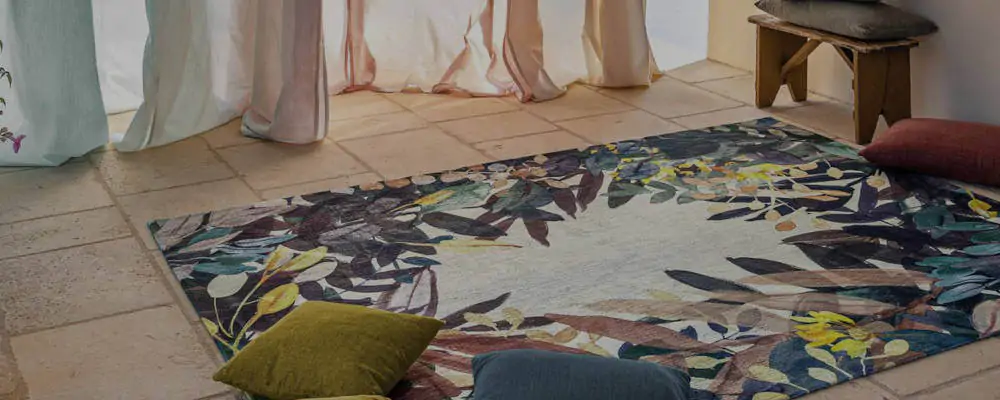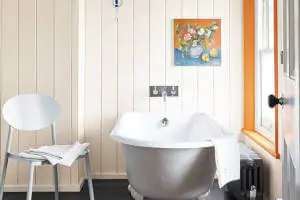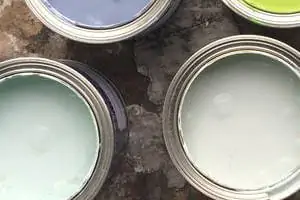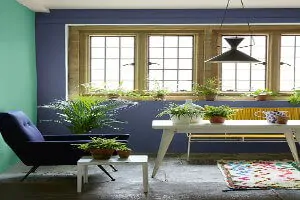Guide to Choosing and Buying Rugs

Finding the Perfect Rug
This guide will help you find the perfect rug for your living space. When shopping for a rug it will help if you work through the following considerations:
- Style – does the room already have a design style you want to fit in with, or is there a look or style you have in mind? Is there a particular style of rug you have in mind.
- Colour – after style you will likely want to make a choice on colour. Think about whether you want the rug to tone in or stand in contrast to the furniture or walls.
- Purpose, Shape and Size – what is the main purpose for the rug, is it to complete a design style or add a decorative flourish, or is it for playing and sitting on, or perhaps it is both functional and decorative like a hallway runner? What size rug do you have in mind, are you looking to fill a room or add a small rug for decoration, or something in between? Do you have a shape in mind?
- Environment & Care – Will the rug be in a high traffic area? Is the rug likely to come into contact with dirt, water or food? Will the rug be in direct sunlight? Answers to these questions, and how much time you may want to spend cleaning and caring for the rug might steer you to certain materials.
1. Rug Styles
There are two style factors to take into consideration when choosing a rug, the style of the room, and the style of the rug. If you have a very clear aesthetic for your interior décor scheme you will want to ensure your rug tones in with it or accentuates it.
A good starting point is to identify your interior design style and see which interior design scheme it most closely aligns with, is it an Art Deco style, a Scandi theme, or a Traditional interior. The good news is there are rugs for all interior design styles, and some which will have been designed with particular design styles in mind, if you want to search for an Art Deco rug, or a Scandi rug, many websites will let you filter based on these settings. Alternatively, you can search for rugs by pattern, with some patterns more likely to offer rug designs which are complimentary to a particular interior design style, for example:
- floral rugs work well for a Traditional or country design scheme
- striped rugs in navies, whites, and reds can work for a coastal or nautical look
- persian inspired rug designs in a Boho theme
- geometric rugs can work well for Scandi interiors
- shaggy rugs can be used for retro themes
- deep pile rugs, or rugs with metallic effects, can be used to enhance a Luxe interior décor style
- plain rugs, or rugs with simple designs, will be the most versatile and can be made to work for most interior design styles
2. Choosing a Rug Colour
Once you have a style in mind you will likely want to make a choice on colour. Think about whether you want the rug to tone in or stand in contrast to the furniture or walls. Colouring can also be used to accentuate the style, for example:
- Scandi – use the rug to tone in or add a pop of colour.
- To add a pop of colour to a Scandi schem, choose colours found in nature, bright reds, natural greens, mustard yellows. Ideally try to tie the colour into other accessories in the room.
- To tone a rug in with a Scandi style, rather than add colour, consider greys and neutrals and focus on the texture. The texture should come from natural materials, like wool, or suggest textures from nature.
- Luxe – consider rugs in blacks, blush, and champagne colours, or perhaps metallic shades, or with shimmer. Be mindful of the other fabrics in the room – do you want it to tie in with velvets, faux-fur or other materials.
- Country or Traditional – consider rug colours from nature, off-whites as well as lighter blues, greens and reds.
- Mid-Century Modern – choose rugs in earthy tones, deep reds, darker browns, olive greens or deep greens, and mustard yellows.
3. Rug Purpose, Shape and Size
When choosing a rug you need to think about its purpose, shape and size. If a rug is to be decorative you will have more freedom on the shape and size, but if it is to serve a purpose, for example to soften a hardwood floor, its shape and size may be dictated by its location.
A rug needs to be proportionate to the room or zone it is intended to fill, it is important to make sure the rug is big enough to fill the space. If a rug is too small it will look out of place, so if in doubt, opt for a bigger size. It is a good idea to measure the space and to mark out with tape or newspaper the size the rug will be.
The shape of the rug should be complimentary to the design aesthetic and to the furniture. If you have flowing furniture, choose rounded flowing rugs. Square rugs and round rugs both work well in square rooms and spaces but don’t always work in rectangular rooms.
The size of the rug can also be determined by its location, below are some simple placement ideas which may help you narrow down the size of rug you want.
Living Room Rugs & Dining Room Rugs
Smaller rugs - position decorative rugs centrally under a coffee table or in front of a fireplace.
Mid-size rugs – medium sized rugs can be placed centrally in larger rooms, under dining tables and chairs, or centrally under the feet of smaller rooms.
Large rugs – large rugs can really help to create zones in an open plan space, or to create a feeling of intimacy or cosiness in larger living rooms. They become a home for furniture.
Bedroom Rugs
Long Bedroom Rugs – long rugs, or even runners, can be used to create a comfortable walking area on either side of a bed.
Decorative Bedroom Rugs – decorative rugs in bedrooms are often placed at the end of beds. They draw your eye into the bed and bedroom, but these are also high traffic areas so can protect the flooring underneath.
Large Bedroom Rugs – large rugs can be used in the same way as living spaces, if you have a large bedroom consider adding a large bed under the rug and bedside tables to create a more intimate zone.
Childrens Room Rugs – decorative rugs in childrens rooms can be placed purely for style, but if you are looking to create a nice play area, or protect the flooring underneath, choose a larger rug.
Hallway Rugs & Kitchen Rugs
Runners – runners and small to medium sized rugs are the way to go for hallways and kitchens. Choose a rug which mirrors the dimensions of the space. If you have a narrow hallway choose a runner, but for a more open space choose a wider rug.
4. Rug Environment & Rug Care
Rugs are made in a very wide range of materials, whilst you will want to focus on the look and feel of the material it is important to consider the location of the rug and what environmental challenges this may present. In order to get the most out of your rug, and to minimise the care and cleaning, you should consider choosing rugs in materials which are appropriate to where it will be placed.
A runner is likely to be in a high traffic area like a hallways or kitchens, this means it may also come into contact with dirt, so pick a runner or rug with a shorter pile for a more durable and easy-clean option, or consider an indoor/outdoor rug, these are weather-resistant and tend to be easy to clean.
Wool is a good choice for high traffic areas, they have some resistance to dirt, are comfortable underfoot and are quite hard-wearing. Wool rugs are the most popular material and they are perfect for dining rooms, main living spaces and bedrooms.
Cotton is another great natural fibre for rugs, often it is blended with other materials. Cotton tends to be used in flatweave rugs, which are often easier to clean than deeper pile alternatives.
Sheepskin and faux-fur can be difficult to clean and should be placed in rooms where they are less likely to be trampled with mud or suffer spillages. Sheepskin and faux-fur are ideally suited to bedrooms.
Viscose is a popular rug material because it offers a silky feel and shimmering luxurious look. Viscose rugs are prone to staining and so should not be placed in high traffic areas, you may also want to avoid putting them in dining rooms so as to avoid spills, but they can add a stylish and elegant look to living rooms and bedrooms.
Natural plant fibre rugs include coir, sisal, and hemp. Rugs made from these materials tend to be harder-wearing making them great choices for under tables and high traffic areas.
TM Interiors
Can’t find what you’re looking for? We can help.
Call our customer support team on +44(0)1733230499 or email us.






